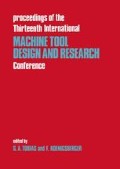Summary
This paper reports on investigations of the dynamic characteristics of joints with loads applied normal to the joint faces, in which an epoxy resin adhesive has been used as the interface bonding material. Joint face surface topography and a range of adhesives with varying properties were examined.
Bonding joint surfaces with this type of adhesive increases both the static and the dynamic stiffness. The stiffness is dependent on the type of machined surface and quality of surface roughness. The range of adhesives available for bonding steel-to-steel all have similar stiffness characteristics. A small increase in damping is achieved when using the epoxy resin adhesives compared with that obtained with dry joints.
Preview
Unable to display preview. Download preview PDF.
References
R. H. Thornley, 1969. ‘A study of some parameters which influence the dynamic stiffness of joints in machine tool structures’, Ph.D. Thesis, University of Manchester.
C. Andrew, J. A. Cockburn and A. E. Waring, 1967–8. ‘Metallic surfaces in contact under normal forces: some dynamic stiffness and damping characteristics’, Proc. J. Mech. E 182, PT. 3K.
A. E. Waring, 1969. ‘The damping in fluid-filled metal-to-metal joints undergoing normal vibration’, Ph.D. Thesis, University of Bristol.
P.E.R.A., 1969. ‘Machine tool joints. Part 2, effect of intermediate viscous films on stiffness and damping of cast iron joints’, Rept., No. 13, March.
T. J. Mentel, 1967. ‘Joint interface layer damping’, Trans. A.S.M.E.J. Engng. Ind., November, 757 — 804
R. H. Thornley, R. Connolly, M. M. Barash and F. Koenigsberger, 1965. ‘The effect of surface topography upon the static stiffness of machine tool joints’. Intern. J. Mach. Tool Design Res., 5, 57–74.
R. Connolly and R. H. Thornley, 1966. ‘The static stiffness of ioints between machined surfaces’, M.T.I.R.A. Rept., No.13, March.
R. Connolly and R. H. Thornley, 1965. ‘The significance of joints of the overall deflection of machine tool structures’, Proc. 6th Intern. M.T.D.R. Conf., Manchester.
R. H. Thornley, R. Connolly and F. Koenigs-Berger, 1967–8. ‘The effect of the flatness of joint faces upon the static stiffness of machine tool joints’, Proc. Inst. Mech. Engrs. 182, Part 1, No. 18.
R. Connolly and R. H. Thornley, 1967. ‘Determining the normal stiffness of joint faces’, Trans. A.S.M.E. J. Engng. Ind. Prod., Engng. Div., Paper 67, No. 6.
D. N. Reshetov and Z. M. Levina, 1956. ‘Damping of oscillations in the couplings of components of machines’, Vestnik Machinostr., No. 12, 3–13.
C. Gong, 1963. ‘Energy dissipation in thin layers of damping material subject to cyclic normal loading’, M.Sc. Thesis, University of Minnesota.
Author information
Authors and Affiliations
Editor information
Editors and Affiliations
Copyright information
© 1973 Macmillan Publishers Limited
About this chapter
Cite this chapter
Thornley, R.H., Lees, K. (1973). Some Static and Dynamic Characteristics of Bonded, Machined Joint Faces. In: Tobias, S.A., Koenigsberger, F. (eds) Proceedings of the Thirteenth International Machine Tool Design and Research Conference. Palgrave, London. https://doi.org/10.1007/978-1-349-01857-4_12
Download citation
DOI: https://doi.org/10.1007/978-1-349-01857-4_12
Publisher Name: Palgrave, London
Print ISBN: 978-1-349-01859-8
Online ISBN: 978-1-349-01857-4
eBook Packages: EngineeringEngineering (R0)

